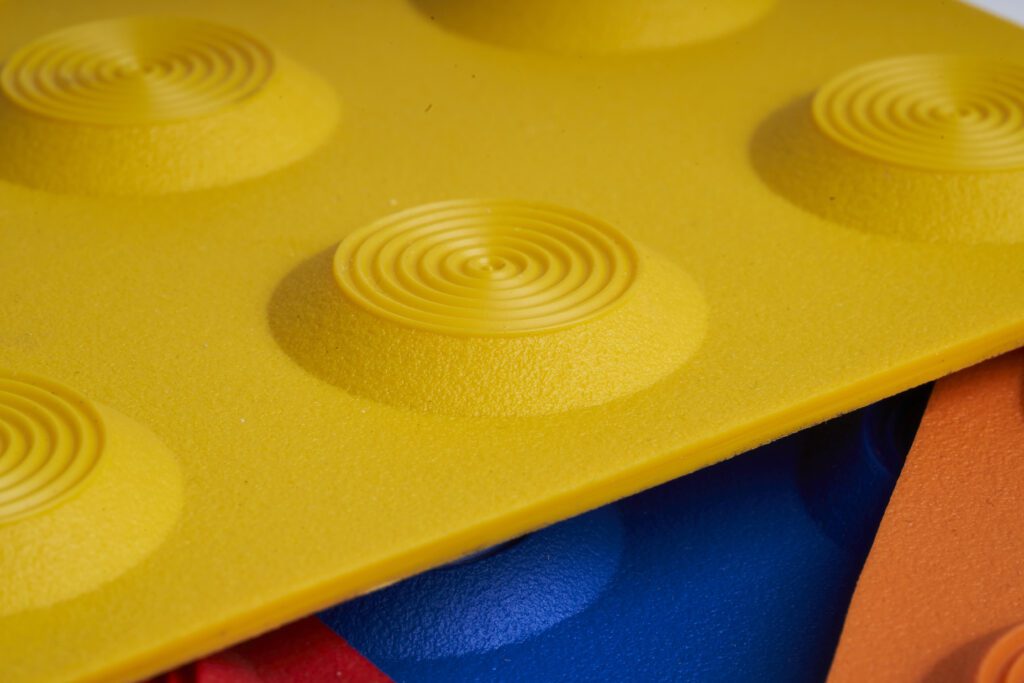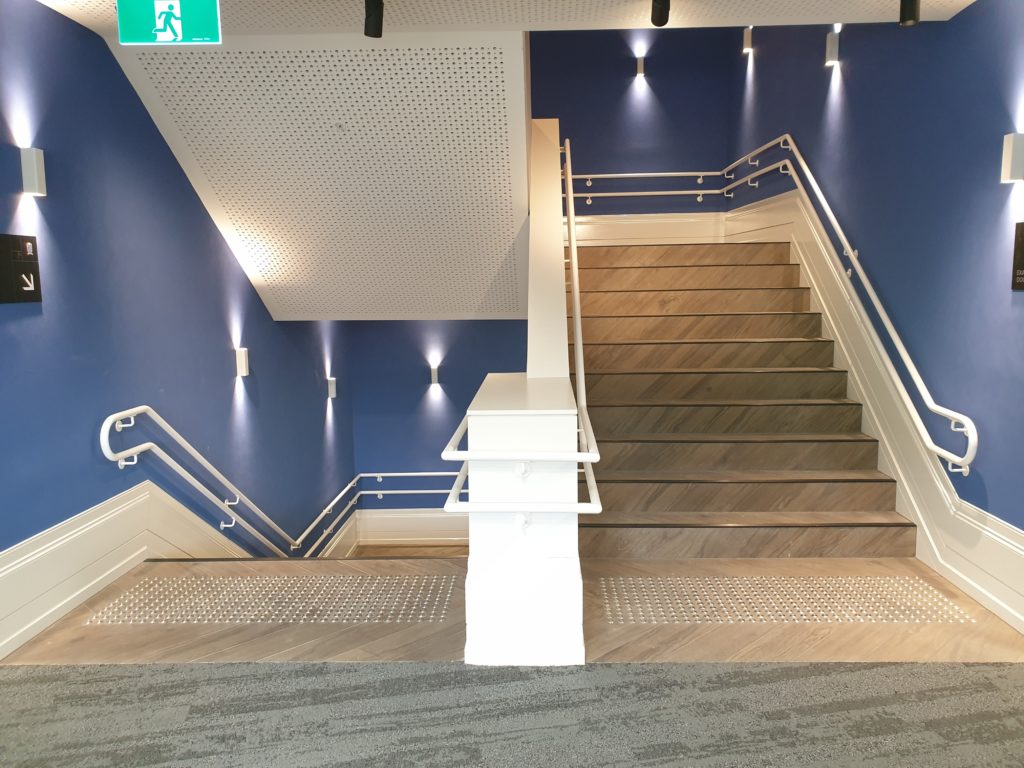Ensuring public safety and accessibility for visually impaired individuals
Around 330,000 Australians currently experience blindness or vision impairment, with a large proportion being over 65 years of age. As Australia’s population continues to age, it is projected that the number of people with vision impairments will double within the next 25 years. With this in mind, the visually impaired often experience a range of difficulties when navigating built areas, including poor orientation, difficulty finding their bearings, and an increased risk of falls.
Whether it’s vision impairments or other forms of disability, we must ensure dignified, safe and independent access for all members of our community. From making outdoor walking paths detectable and safe to installing floor and safety features such as tactile indicators and stair nosings, there are many ways for building professionals to comply with safety regulations and anti-discrimination standards.
In today’s blog, we’ll cover the different types of tactile ground surface indicators (TGSIs) and their relevant applications, as well as tips on choosing the best tactiles for your project. According to the Australian Standards AS/NZS 1428.4, there are also specific compliance requirements to note when installing tactiles across new building works and renovations which we’ll also explore below.
What are Tactile Indicators?

Tactile Ground Surface Indicators (TGSIs), often referred to as tactile indicators or tactiles, are floor safety features designed to empower the visually impaired to confidently and safely navigate public spaces. Combined with other environmental cues, tactile indicators often play two different but complementary public safety roles: providing directional guidance and warnings of upcoming hazards or obstructions.
You’ll often find tactiles installed at stairways, ramps, escalators and moving walks – shared access points that are built to improve traffic flows but are often still challenging for the vision impaired. Here is a list of public access areas that MUST have tactiles installed to ensure safe access for visually impaired pedestrians.
Unfortunately, not all environments effectively use tactiles which can pose several challenges including
- Higher risk of trips and falls
- Disorientation
- Diminished mobility due to loss of confidence
- Social exclusion
An inability or lack of confidence to safely navigate their environment not only risks their physical safety but can also adversely impact their overall health and well-being.
The Importance of Australian Standards in Tactile Indicators
With the built environment posing a significant safety and access risk for the vision impaired, the Australian Standards have developed a set of initiatives and guidelines to improve access and equality for all. Prioritising the effective design and planning of public spaces, tactile indicators play a critical role in providing necessary warnings of impending hazards as well as crucial directional information. According to AS/NZS 1428.4, all newly constructed and renovated public or private works must include tactile indicators.
This Australian Standard guideline is further reinforced by the Building Code of Australia (BCA) Section D Clause 3.8, as well as the Disability Discrimination Act (DDA).
Types of Tactile Indicators Per Australian Standards
In general, there are two main types of tactile indicators, namely Warning Tactile Indicators and Directional Tactile Indicators. While both tactile types provide important directional and orientation cues for the blind and vision impaired, they serve slightly different but complementary purposes.
Warning Tactile Indicators (also known as Hazard Tactile Indicators)

Warning tactile indicators, also commonly referred to as hazard tactile indicators, are textured features installed onto walking surfaces to function as a ‘stop’ sign. These warning TGSIs alert any pedestrians who may be blind or vision-impaired of potential hazards in their path of travel, prompting them to stop and assess the situation before moving forward.
Commonly installed at
- Ramps or ramp landings
- Kerb ramps
- Steps and stairs
- Escalators
Directional Tactile Indicators (also known as Leading Tactile Indicators)

Directional tactile indicators, also commonly referred to as leading tactile indicators, are textured features comprising directional bars, installed onto walking surfaces to provide directional orientation. These directional TGSIs assist blind and vision-impaired pedestrians to determine and navigate their next best accessible path of travel.
Commonly installed in open areas to assist with continuous navigation, directional tactile indicators also guide people to safely deviate from one path of travel to another.
Commonly installed at
- Crossing points and intersections
- Kerb ramps
- Open areas
- Public transportation access points
- Building entrances
Both warning and directional tactile indicators are available in different formats and materials to suit your project
Both warning and directional tactiles are available in two different application formats:
- Individual tactiles – installed in custom dimensions depending on the application area
- Plate format – installed in a pre-set plate format of 300mm x 600mm or 300mm x 300mm for standard applications
Choosing the best tactile materials
Once you’ve determined the type of tactile indicators you need (warning and/or directional), as well as your preferred format (individual and/or plate), you can also choose specific tactile materials to achieve your project’s functional and aesthetic requirements.
As long as they comply with the relevant dimensional and spacing requirements of the Australian Standards, tactile indicators can be manufactured from any material that will withstand the harsh roading environment.
Here are some popular options:
- Solid Brass Tactile Indicators – a durable and aesthetically timeless option, ideal for retrofitting across interior and exterior applications
- Stainless Steel Tactile Indicators – offer premium durability, perfect for retrofitting to existing applications across interior and exterior environments
- Aluminium Tactile Indicators – affordable choice for interior use, available in silver or bronze upon request
- Polyurethane Tactile Indicators – available in a huge range of colours and suitable for both interior and exterior use
- Ceramic Tactile Indicators – UV-stabilised for both interior and exterior applications
- Fibreglass Tactile Indicators – highly impact resistant and great for high traffic areas
With versatile tactile solutions to suit every application, our friendly team can talk you through all the available options, including bespoke designs. Read more about selecting the right type of tactile indicator for your projects.
Installation of Tactile Indicators under Australian Standards

Tactile Ground Surface Indicators (TGSIs) must be installed in accordance with AS1428.4 .1-2009.
While there may be variances between tiled TGSIs and individual TGSIs, here are some general tips when preparing installation surfaces and planning the layout:
- Substrates must be virgin, uncontaminated, unsealed and free of hydrostatic pressure.
- Thoroughly clean all surfaces from dirt, moisture and grime, and conduct a final clean with a suitable non-residual cleaner, to ensure the adhesive has maximum surface area contact with the substrate.
- Any surface irregularities must be corrected before installation of the TGSIs
- Lay out the TGSis in the designated areas using a straight edge/ string line or tape to ensure straight lines.
- Stairs: All TGSIs must be installed 300mm from the leading nosing edge at the top and bottom of the stair flight, and 600mm deep to the full width of the path of travel
- Ramps: All TGSIs must be installed 300mm from the change in plane, and 600mm deep to the full width of the path of travel
- The 600mm depth requirement is exempt when there is a solid wall within 3 meters of the top of the stairs or ramp. In this scenario, the tactile tiles/pads need to be 300mm deep to advise the visually impaired to turn right or left within 3 meters.
While we’ve provided guides below, please be sure to seek specific advice from a reputable and accredited TGSI installer to ensure your complete compliance. If in doubt, please contact our team for expert guidance.
Learn more about the recommended installation process: Classic Tredfx Tactile Indicators: Individual | Classic Tredfx Tactile Indicators: Tiles
Ascertain your project’s compliance with Australian Standards and relevant safety laws
The built environment and high-traffic areas can be a challenge for everyday Australians to navigate, let alone those living with blindness and vision impairments. As a community, we should make it our priority to ensure safe and equal access for all members of the public, whether it be a renovation or a new project.
To achieve a satisfactory and compliant result as per Australian Standards, the project needs to be planned and set out before any installation. If TGSIs aren’t properly installed according to recommended installation requirements and maintenance guidelines, they can pose a public safety risk and access hindrance, defeating their purpose. Furthermore, any non-compliance issues can be a costly fix while delaying your project’s handover timelines.

Classic offers architecturally-designed tactile ground surface indicators, stair nosings, and a range of floor and safety products, in a diverse array of styles, materials and colours to support your project goals. Complying with all Australian Standards, you can also use our ‘Visualise It’ 3D/AR Product Visualisation Tool to get an accurate sense of scale, depth and spatial when selecting your preferred products.
Our team can also assist you with assessing the best access products for your needs, as well as providing efficient installation services for an end-to-end solution.
For a friendly consultation, quote or for more information on any of our products, please get in touch with us by calling 1300 244 377 or emailing us at info@classic-arch.com.






